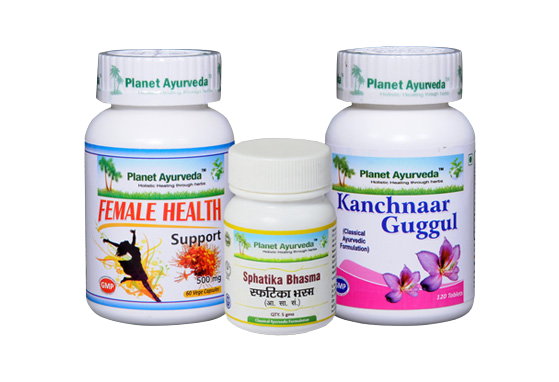Ureaplasma Vaginitis – Causes, Symptoms, Prevention & Ayurvedic Treatment
ABSTRACT
Ureaplasma are bacteria groups which reside in the urogenital and respiratory tract of humans. These microorganisms are freely found in nature and in the human body; helps in fighting infection, digestion and mainly keeps reproductive health in check. Normally these microorganisms are harmless but when their quantity increases to more than normal then they form colonies & inflame the surrounding cells/tissue thus leading to infection. This infection may lead to bacterial vaginosis termed as “ureaplasma vaginitis”. Let’s discuss it in detail!
INTRODUCTION
Infection due to Ureaplasma gets transmitted from one person to another mainly via sexual activity. It enters the body via the urethra or vagina and can also pass to the child from the mother during childbirth. As we know that these bacteria are already present in our body normally, we can say that a weak immune system may result in overgrowth of these microorganisms. Ureaplasma vaginitis is a STI/STD (sexually transmitted disease) as it spreads via sexual activity. Ureaplasma belongs to the class of mycoplasma which are the smallest organisms of their type known to man. These classes of bacteria do not have any outer cell wall hence are resistant to various common antibiotics and also to penicillin. Thus this condition of ureaplasma is very tricky to cure. One must firstly try to avoid having such communicable infection by using proper preventive measures and if the infection is caught then must get treated at the earliest.

CAUSES
Mainly ureaplasma vaginitis spreads to one another via sexual contact, via urethra and vagina. It can also pass to the baby from the mother during delivery. People with an immune system, or patients who take immunosuppressants are more susceptible to ureaplasma infection.
SYMPTOMS
Most patients do not experience any symptoms and may act as carriers. Symptoms are as follows-
- Pain during micturition
- Burning sensation
- Vaginal or urethral discharge
- Bad odour
- Inflammation
COMPLICATIONS
- Premature labour (not the ureaplasma itself causes premature delivery but the symptoms like infection of cervix, vagina, inflammation may lead to preterm childbirth)
- Increased risk of kidney stones
- Respiratory problems in newborns
- Premature rupture of foetal membrane
- Chorioamnionitis
- Funisitis
DIAGNOSIS
- Urine routine- analysation of urine for presence of any kind of bacterial infection in the urine.
- Swab test- a sample from vagina, anus, throat, cervix is taken using a swab for testing for any infection.
- Endometrial swab
- Endometrial biopsy- A small tissue piece is taken out of endometrium for cell culture to rule out infection
Prevention
- Use condoms- One must use condoms or femedoms during intercourse are the first line of defence against various infections such as H.I.V, chlamydia, gonorrhoea, syphilis, ureaplasma vaginitis etc.
- Limit your number of sex partners- do not have multiple sexual partners as it increases the chances of ureaplasma infection.
- Get regular screenings- Person who is more sexually active should get tested for STDs on a regular basis.
- Avoid douching- Douching is a vaginal cleansing procedure which must be avoided because it alters the normal flora of vagina which increases the chances of infection.
AYURVEDIC OVERVIEW OF UREAPLASMA VAGINITIS
Vaginitis is the commonest gynaecological problem reported by women. In Ayurveda diseases of the female reproductive system are mainly explained under “yoni vyapad”. Vaginal candidiasis, trichomoniasis and bacterial vaginosis (ureaplasma vaginitis) are some common types of vaginal infections. Main cardinal symptoms of Yoni vyapad are:-
- Yoni srava (vaginal discharge)
- Yoni kaṇḍu (itching)
- Daurgandhya (bad odour)
In Ayurvedic classics vitiation of vata dosha (kinetic energy) is said to be the main cause of this condition. Even though ancient scripture directs towards vata vitiation, there is an equal role of other two doshas – pitta and kapha (thermal and potential energy). Vitiation of vata dosha causes symptoms like pain , inflammation etc whereas burning sensation, bad odour, suppuration, fever like symptoms are due to the pitta imbalance. Kapha vitiation causes white discharge, mucoid secretions, itching and feeling of cold etc. Due to this vitiation of doshas there is imbalance in the flora of vagina i.e the acidic nature of vagina changes to basic hence causing an increased number of ureaplasma bacteria causing the infection. Also STDs and other communicable diseases are kept under “AGANTUJA VYADHI” in ayurveda.
AYURVEDIC MEDICATIONS USED IN UREAPLASMA VAGINITIS
- Chandraprabha vati
- Ashokarishta
- Pushyanug churna
- Triphala guggul
- Madhusnuhi rasayan
- Dashmoola kwath
- Triphala churna
- Yoni prakshalana (vaginal wash) with aragwadhadi kashayam, panchavalkala kashaya.
- Drinking adequate fluids
- Maintain hygiene
- Take Proper rest.
HERBAL REMEDIES FOR UREAPLASMA VAGINITIS BY PLANET AYURVEDA
Planet Ayurveda is a GMP and ISO-certified company known for its herbal and natural products. All formulations are prepared as per the ancient texts. Planet Ayurveda offers the formulations of best herbs for various ailments. These herbal remedies are as follows
1. Pradrantak churna
It is a polyherbal formulation from Planet Ayurveda used in numerous gynaecological disorders. It has anti inflammatory, antibacterial, anti tumour properties along with this it is also given in uterine cyst and fibroids. This churna mainly consists of Arjuna (Terminalia arjuna) being astringent in nature and acts as stambhana(clotting agent) which is useful in bleeding disorders, and is helpful in pacifying pitta and kapha dosha. Lodhra (Symplocos racemosa) helps in managing the fluid discharge as it is astringent in nature, hemostatic & anti inflammatory, and pacifies kapha and pitta dosha. Ashoka (Saraca asoca) acts as a uterine sedative and is also astringent in nature as a result acts as a coagulative agent, helping in healing internal wounds.
Dosage– 1 teaspoon twice a day.
2. Kaishore Guggul
This is a pure classical herbal formulation that helps in healing wounds and subsides inflammation and also acts as blood cleanser. Also flushes out toxins from the body and improves digestion. Contains Haritaki (Terminalia chebula), Bibhitaki (Terminalia bellirica), Amalaki (Embillica officinalis), Guduchi (Tinospora cordifolia), Guggul (Comiphora mukul) etc. Contents of this formulation pacifies all 3 doshas (vata, pitta, kapha) but mainly it works on vata dosha giving good results in inflammatory conditions.
Dosage- 2 tablets twice a day
3. Chandraprabha Vati
A pure classical formulation given in the condition of urine infection or in other urine disorders mainly. Apart from this chandraprabha vati is also given in abdominal colic, lower back pain and many gynaecological problems. Contents in this formulation helps in pacifying all 3 doshas- vata, pitta, kapha (kinetic, thermal, potential). Ingredients- kapoor (Cinnamomum camphora), Haridra (curcuma longa), Shilajit (Asphaltum punjabinum), Guggul (Comiphora mukul) etc. This medication has a very soothing effect and relieves the burning sensation. Guggul pacifies vata dosha relieving inflammation and pain etc. Shilajit being a good immunomodulator is also good in infertility, reduces stress and anxiety.
Dosage– 2 tablets twice a day.
4. Lodhrasav
Lodhrasav also called as rodhrasava, lodhrasav is a classic ayurvedic liquid formulation. It is used in heavy menstruation or in DUB (dysfunctional uterine bleeding). As the name suggests it contains lodhra (Symplocos racemosa) and due to its properties like astringent in nature, hemostatic & anti inflammatory, and pacifies kapha and pitta dosha. It is also used in heavy menstruation or in DUB (dysfunctional uterine bleeding) as it relieves pain and heavy blood flow. Lodhra pacifies pitta and kapha dosha to a great extent hence is used in this condition.
Dosage– 2 tsp twice daily
5. Sphatika bhasma
it is a powdered form of classical ayurvedic medication also called kankshi, tubra, shubhra, phataki with chemical formula – K2SO4.Al2(SO4)3.24H2O . It is used in various ailments like haematemesis, menorrhagia, dry cough, leucoderma, visarpa etc. Contains Sphatika (Alum) which pacifies vata and pitta. Apart from a potent detoxifying agent Sphatika also stops bleeding and is a good wound healer. It is a potent gynaecological medicine as it removes toxins out of the body, reduces inflammation and is antiseptic in nature.
6. Chandanadi Vati
Chandanadi Vati is a herbal tablet formulation which is made by planet ayurveda using ingredients such as Safed Chandan (Sandalwood), Gokshura (Tribulus Terrestris), Choti Elaichi (Elettaria cardamomum) and many more. It is helpful in balancing Pitta and Kapha doshas and maintains healthy metabolism of the body. Promotes healthy digestion and alleviates respiratory problems.
Dosage- 2 tablets twice daily after meals with plain water.
Usage – This sphatika bhasma is used as genital wash in this condition. 1-2 pinch of this powder to 5 litres of water and have a sitz bath in the tub for 25-30 minutes.
Contact Planet Ayurveda Support Team to provide you the costing/ordering and delivery information at – costing.planetayurveda@gmail.com or Call at 0172-521-4040 (India), +91-172-521-4040 (Outside India) or Whatsapp at (+91) 842-749-4030.
CONCLUSION
Ureaplasma is the most common cause of bacterial vaginosis which is curable. It starts as a normal uti infection and gradually increases displaying all the above mentioned symptoms. To rule out any chances of infection regular investigations must be done if one is indulged in regular sex with multiple partners. And if diagnosed with ureaplasma infection; treatment must be started at the earliest to avoid major complications. This condition is difficult to treat but herbal remedies developed by Planet Ayurveda are very effective in treating ureaplasma vaginitis.




